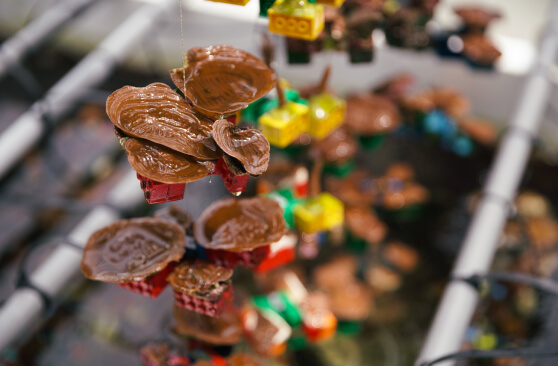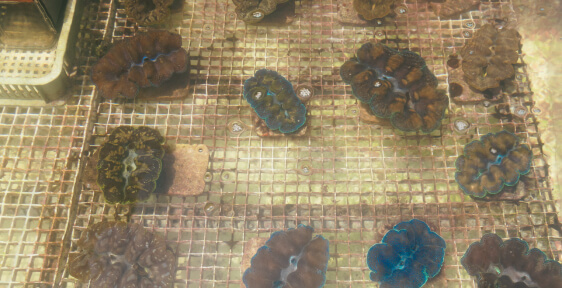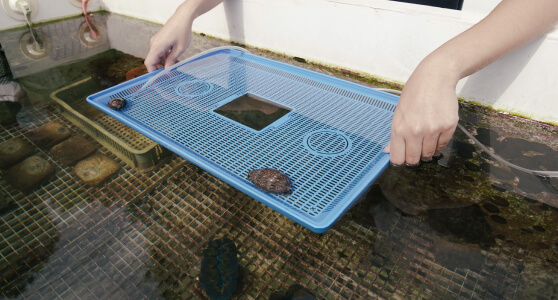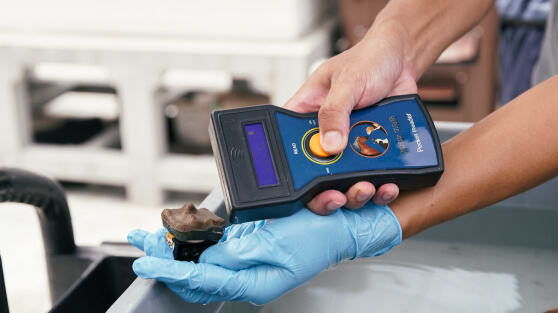Making Waves for the Future of Marine Life
Enhancing Mariculture Capabilities in Singapore
Giant clams are reef builders, food factories, shelters for shrimps and crabs, and water filters all rolled into one. When they start to disappear from the reefs, it is a clear indicator that their reef habitats are in trouble."
“Did you know that the biggest giant clam is about one and a half metres long? That’s as big and tall as me!” Dr Neo Mei Lin commented excitedly, gesturing with her hands to show just how big that is.
A marine biologist and conservationist, Dr Neo has been studying giant clams for more than 10 years, and is probably their biggest advocate. Her passion for these large marine shellfish has even earned her
the nickname – ‘The Giant Clam Girl’.
“Giant clams are reef builders, food factories, shelters for shrimps and crabs, and water filters all rolled into one,” shared Dr Neo. “When they start to disappear from the reefs, it is a clear indicator that their reef habitats are in trouble.”
The giant clam and many other marine invertebrate organisms are rapidly and unsustainably caught as either seafood or to support the global aquarium trade. In some instances, the intense pressures of exploitation have caused population collapses in commercially valuable marine species such as the sea cucumbers. As the global demands for certain marine species continue to grow, we face the possibility that none of them will be left to supplement our purposes.
Since October 2020, Dr Neo and a team of researchers from the Tropical Marine Science Institute and Department of Biological Sciences, under the National University of Singapore, have been leading a three-year mariculture research project supported by Temasek Foundation.
There are two major goals that we have for this project. The first one is to improve the current culture protocols of three groups of marine animals – several species of the hard corals, one species of giant clam, and one species of cowrie. The second is to improve tracking and traceability of individual animals.”
Interestingly, their research to study these endangered, colourful corals has led them to something that is equally colourful – toy building blocks. But what do the much-loved toy blocks have to do with the cultivation of these marine animals?
“Hard corals are a fundamental framework of coral reef ecosystems, and we’ve always been finding ways to make coral propagation less invasive so that we don’t disturb the animals per se,” said Dr Neo. This has led the team to develop a novel method of using building blocks, like Lego, to grow coral fragments. They are hung on fishing lines to create vertical nurseries that maximise tank space in an aquarium environment.
Just as the team is looking at propagating corals in a sustainable and less invasive manner, they are also investigating feasible ways to reproduce giant clams – specifically, the native boring giant clam – and the lesser known cowries.
Both these animals are highly sought for their ornamental value; the boring giant clams for their petite sizes and colourful tissues, and the cowries, for their beautiful and enigmatic shells. However, knowledge of their biology remains little known. The team has been building up their research on understanding these animals such as their living habits and behaviour, their diets and even the optimal water and temperature conditions they thrive in before they can successfully induce spawning and begin the process of cultivating their babies in captivity.
“We would really like to see how our research outcomes can be fitted for the industry; in this case, the aquarium trade industry. As a start, we want to engage them by talking about the importance of choosing sustainable supplies of marine organisms in their practices, and discussing how our research can help to locally develop the infrastructure and capacity-building to support a sustainable trade,” Dr Neo said earnestly.
Dr Neo also hopes that more can be done to educate and raise environmental awareness such as incorporating environmental biology knowledge into the core education syllabus to spur future generations to have a deeper appreciation of local biodiversity.
“For me, our lives and well-being are very closely linked to Nature – the clean air we breathe and the fresh seafood we eat. I hope through the work I do, I can leave my daughter a better ocean, so that when she’s older, she will still be able to see some of these places that I enjoyed in my youth”.
Watch Their Story
Mariculture Research Project by the National University of Singapore
What is the study about: To study and explore ways on enhancing mariculture capabilities of three marine organisms – hard corals, giant clams and cowries that will lend support in research, conservation and aquarium trade, including traceability of species.
Traceability of marine species allows traders to estimate the source localities of organism stocks, as well as how they are sourced and handled, all the way until they reach the import country. Furthermore, when the source is authenticated (e.g. comes from a sustainable supplier), the value of the imported animals will likely increase. Some of the tracing methods that the team are examining include techniques such as radio-frequency identification (RFID) tags and genome subsampling-based sequencing.
Besides its applications in research, the ability to tag and track sustainably cultured stocks is crucial in implementing and enforcing sustainable practices that allows management of demands in the booming aquarium trade industry.
The industry may also involve government agencies such as the National Parks Board (NParks) that is presently responsible for enhancing and managing Singapore’s urban ecosystems, including the regulation and enforcement of wildlife trade as the Scientific and Management Authority of CITES (Convention on the International Trade in Endangered Species of Flora and Fauna).



